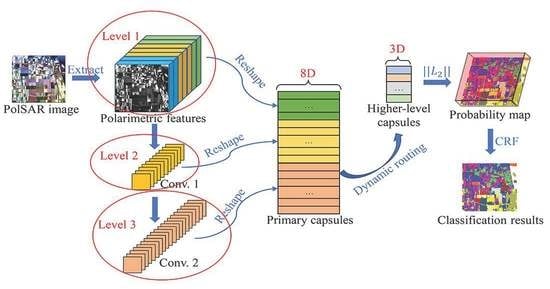PolSAR Image Land Cover Classification Based on Hierarchical Capsule Network
Abstract
:1. Introduction
- (1)
- The HCapsNet is proposed for land cover classification of PolSAR images. It can simultaneously consider the deep features obtained at different network levels, which describes the polarimetric scattering information of land covers more comprehensively with small training sample size, and significantly reduces the misclassification of class boundaries.
- (2)
- The CRF is combined with the HCapsNet to further refine the classification results. The intra-class misclassifications can be reduced by the spatial information constraints of the CRF.
- (3)
- We adopt three discriminative attributes for land covers of PolSAR data, i.e., phase, amplitude, and polarimetric decomposition, to uniformly describe the scattering mechanism of land covers with different sensors, bands, and resolutions. Moreover, the generalization performance of the proposed method is verified to be better than other comparison methods.
2. Methodology
2.1. Polarimetric Feature Extraction
2.2. Construction of the Primary Capsule Layer
2.3. Construction of the Higher-Level Capsule Layer
2.4. Conditional Random Field
2.5. Implementation Details
| Algorithm 1 Proposed method |
|
3. Experiment Results and Analysis
3.1. Data Description and Parameter Settings
3.2. Classification Results of the AIRSAR Flevoland Dataset
3.3. Classification Results of the AIRSAR San Francisco Dataset
3.4. Classification Results of the GF-3 Dataset
3.5. Analysis of the Performance
4. Discussion
4.1. Contributions of Polarimetric Features
4.2. Comparison of Different Feature Extractors
4.3. Effect of the CRF
4.4. Generalization Performance
5. Conclusions
Author Contributions
Funding
Acknowledgments
Conflicts of Interest
References
- Zhang, F.; Ni, J.; Yin, Q.; Li, W.; Li, Z.; Liu, Y.; Hong, W. Nearest-regularized subspace classification for PolSAR imagery using polarimetric feature vector and spatial information. Remote Sens. 2017, 9, 1114. [Google Scholar] [CrossRef] [Green Version]
- Li, L.; Liu, X.; Chen, Q.; Yang, S. Building damage assessment from PolSAR data using texture parameters of statistical model. Comput. Geosci. 2018, 113, 115–126. [Google Scholar] [CrossRef]
- Eom, K.B. Fuzzy clustering approach in unsupervised sea-ice classification. Neurocomputing 1999, 25, 149–166. [Google Scholar] [CrossRef]
- Gomez, L.; Alvarez, L.; Mazorra, L.; Frery, A.C. Fully PolSAR image classification using machine learning techniques and reaction-diffusion systems. Neurocomputing 2017, 255, 52–60. [Google Scholar] [CrossRef]
- Xiang, D.; Ban, Y.; Wang, W.; Su, Y. Adaptive superpixel generation for polarimetric SAR images with local iterative clustering and SIRV model. IEEE Trans. Geosci. Remote Sens. 2017, 55, 3115–3131. [Google Scholar] [CrossRef]
- Guan, D.; Xiang, D.; Dong, G.; Tang, T.; Tang, X.; Kuang, G. SAR image classification by exploiting adaptive contextual information and composite kernels. IEEE Geosci. Remote Sens. Lett. 2018, 15, 1035–1039. [Google Scholar] [CrossRef]
- Yin, Q.; Cheng, J.; Zhang, F.; Zhou, Y.; Shao, L.; Hong, W. Interpretable POLSAR Image Classification Based on Adaptive-dimension Feature Space Decision Tree. IEEE Access 2020, 8, 173826–173837. [Google Scholar] [CrossRef]
- Bi, H.; Xu, L.; Cao, X.; Xue, Y.; Xu, Z. Polarimetric SAR image semantic segmentation with 3D discrete wavelet transform and Markov random field. IEEE Trans. Image Process. 2020, 29, 6601–6614. [Google Scholar] [CrossRef]
- De, S.; Bruzzone, L.; Bhattacharya, A.; Bovolo, F.; Chaudhuri, S. A novel technique based on deep learning and a synthetic target database for classification of urban areas in PolSAR data. IEEE J. Sel. Top. Appl. Earth Obs. Remote Sens. 2017, 11, 154–170. [Google Scholar] [CrossRef]
- Hariharan, S.; Mandal, D.; Tirodkar, S.; Kumar, V.; Bhattacharya, A.; Lopez-Sanchez, J.M. A novel phenology based feature subset selection technique using random forest for multitemporal PolSAR crop classification. IEEE J. Sel. Top. Appl. Earth Obs. Remote Sens. 2018, 11, 4244–4258. [Google Scholar] [CrossRef] [Green Version]
- Chen, S.W.; Tao, C.S. PolSAR image classification using polarimetric-feature-driven deep convolutional neural network. IEEE Geosci. Remote Sens. Lett. 2018, 15, 627–631. [Google Scholar] [CrossRef]
- Li, Y.; Chen, Y.; Liu, G.; Jiao, L. A novel deep fully convolutional network for PolSAR image classification. Remote Sens. 2018, 10, 1984. [Google Scholar] [CrossRef] [Green Version]
- Xie, W.; Ma, G.; Zhao, F.; Liu, H.; Zhang, L. PolSAR image classification via a novel semi-supervised recurrent complex-valued convolution neural network. Neurocomputing 2020, 388, 255–268. [Google Scholar] [CrossRef]
- Touzi, R. Target scattering decomposition in terms of roll-invariant target parameters. IEEE Trans. Geosci. Remote Sens. 2006, 45, 73–84. [Google Scholar] [CrossRef]
- Gosselin, G.; Touzi, R.; Cavayas, F. Polarimetric Radarsat-2 wetland classification using the Touzi decomposition: Case of the Lac Saint-Pierre Ramsar wetland. Can. J. Remote Sens. 2014, 39, 491–506. [Google Scholar] [CrossRef]
- Touzi, R.; Omari, K.; Sleep, B.; Jiao, X. Scattered and received wave polarization optimization for enhanced peatland classification and fire damage assessment using polarimetric PALSAR. IEEE J. Sel. Top. Appl. Earth Obs. Remote Sens. 2018, 11, 4452–4477. [Google Scholar] [CrossRef]
- Wang, H.; Magagi, R.; Goïta, K.; Trudel, M.; McNairn, H.; Powers, J. Crop phenology retrieval via polarimetric SAR decomposition and Random Forest algorithm. Remote Sens. Environ. 2019, 231, 111234. [Google Scholar] [CrossRef]
- Muhuri, A.; Manickam, S.; Bhattacharya, A. Scattering mechanism based snow cover mapping using RADARSAT-2 C-Band polarimetric SAR data. IEEE J. Sel. Top. Appl. Earth Obs. Remote Sens. 2017, 10, 3213–3224. [Google Scholar] [CrossRef]
- Wang, H.; Magagi, R.; Goita, K.; Jagdhuber, T. Refining a polarimetric decomposition of multi-angular UAVSAR time series for soil moisture retrieval over low and high vegetated agricultural fields. IEEE J. Sel. Top. Appl. Earth Obs. Remote Sens. 2019, 12, 1431–1450. [Google Scholar] [CrossRef]
- Liu, J.w.; Ding, X.h.; Lu, R.k.; Lian, Y.f.; Wang, D.z.; Luo, X.l. Multi-View Capsule Network. In International Conference on Artificial Neural Networks; Springer: Cham, Switzerland, 2019; pp. 152–165. [Google Scholar]
- Yang, S.; Lee, F.; Miao, R.; Cai, J.; Chen, L.; Yao, W.; Kotani, K.; Chen, Q. RS-CapsNet: An Advanced Capsule Network. IEEE Access 2020, 8, 85007–85018. [Google Scholar] [CrossRef]
- Cheng, X.; He, J.; He, J.; Xu, H. Cv-CapsNet: Complex-valued capsule network. IEEE Access 2019, 7, 85492–85499. [Google Scholar] [CrossRef]
- Sabour, S.; Frosst, N.; Hinton, G.E. Dynamic routing between capsules. arXiv 2017, arXiv:1710.09829. [Google Scholar]
- Hinton, G.E.; Sabour, S.; Frosst, N. Matrix capsules with EM routing. In Proceedings of the International Conference on Learning Representations, Vancouver, BC, Canada, 30 April–3 May 2018. [Google Scholar]
- Guo, Y.; Pan, Z.; Wang, M.; Wang, J.; Yang, W. Learning Capsules for SAR Target Recognition. IEEE J. Sel. Top. Appl. Earth Obs. Remote Sens. 2020, 13, 4663–4673. [Google Scholar] [CrossRef]
- Phaye, S.S.R.; Sikka, A.; Dhall, A.; Bathula, D. Dense and diverse capsule networks: Making the capsules learn better. arXiv 2018, arXiv:1805.04001. [Google Scholar]
- Wang, A.; Wang, M.; Wu, H.; Jiang, K.; Iwahori, Y. A Novel LiDAR Data Classification Algorithm Combined CapsNet with ResNet. Sensors 2020, 20, 1151. [Google Scholar] [CrossRef] [PubMed] [Green Version]
- Zhang, W.; Tang, P.; Zhao, L. Remote sensing image scene classification using CNN-CapsNet. Remote Sens. 2019, 11, 494. [Google Scholar] [CrossRef] [Green Version]
- Ma, W.; Xiong, Y.; Wu, Y.; Yang, H.; Zhang, X.; Jiao, L. Change detection in remote sensing images based on image mapping and a deep capsule network. Remote Sens. 2019, 11, 626. [Google Scholar] [CrossRef] [Green Version]
- Zhu, K.; Chen, Y.; Ghamisi, P.; Jia, X.; Benediktsson, J.A. Deep convolutional capsule network for hyperspectral image spectral and spectral-spatial classification. Remote Sens. 2019, 11, 223. [Google Scholar] [CrossRef] [Green Version]
- Deng, F.; Pu, S.; Chen, X.; Shi, Y.; Yuan, T.; Pu, S. Hyperspectral image classification with capsule network using limited training samples. Sensors 2018, 18, 3153. [Google Scholar] [CrossRef] [PubMed] [Green Version]
- Shang, R.; He, J.; Wang, J.; Xu, K.; Jiao, L.; Stolkin, R. Dense connection and depthwise separable convolution based CNN for polarimetric SAR image classification. Knowl. Based Syst. 2020, 194, 105542. [Google Scholar] [CrossRef]
- Lafferty, J.; McCallum, A.; Pereira, F.C. Conditional Random Fields: Probabilistic Models for Segmenting and Labeling Sequence Data. In Proceedings of the 18th International Conference on Machine Learning 2001 (ICML 2001), Williamstown, MA, USA, 28 June–1 July 2001. [Google Scholar]
- Krähenbühl, P.; Koltun, V. Efficient inference in fully connected crfs with gaussian edge potentials. Adv. Neural Inf. Process. Syst. 2011, 24, 109–117. [Google Scholar]
- Wen, Z.; Wu, Q.; Liu, Z.; Pan, Q. Polar-Spatial Feature Fusion Learning With Variational Generative-Discriminative Network for PolSAR Classification. IEEE Trans. Geosci. Remote Sens. 2019, 57, 8914–8927. [Google Scholar] [CrossRef]
- Wang, S.; Xu, Z.; Zhang, C.; Zhang, J.; Mu, Z.; Zhao, T.; Wang, Y.; Gao, S.; Yin, H.; Zhang, Z. Improved winter wheat spatial distribution extraction using a convolutional neural network and partly connected conditional random field. Remote Sens. 2020, 12, 821. [Google Scholar] [CrossRef] [Green Version]
- Zhang, S.; Hou, B.; Jiao, L.; Wu, Q.; Sun, C.; Xie, W. Context-based max-margin for PolSAR image classification. IEEE Access 2017, 5, 24070–24077. [Google Scholar] [CrossRef]
- Ziegler, V.; Lüneburg, E.; Schroth, A. Mean backscattering properties of random radar targets-A polarimetric covariance matrix concept. In Proceedings of the IGARSS’92; Proceedings of the 12th Annual International Geoscience and Remote Sensing Symposium, Houston, TX, USA, 26–29 May 1992; Volume 1, pp. 266–268.
- Buckley, J.R. Environmental change detection in prairie landscapes with simulated RADARSAT 2 imagery. In Proceedings of the IEEE International Geoscience and Remote Sensing Symposium, Toronto, ON, Canada, 24–28 June 2002; Volume 6, pp. 3255–3257. [Google Scholar]
- Cloude, S.R.; Pottier, E. An entropy based classification scheme for land applications of polarimetric SAR. IEEE Trans. Geosci. Remote Sens. 1997, 35, 68–78. [Google Scholar] [CrossRef]
- Lönnqvist, A.; Rauste, Y.; Molinier, M.; Häme, T. Polarimetric SAR data in land cover mapping in boreal zone. IEEE Trans. Geosci. Remote Sens. 2010, 48, 3652–3662. [Google Scholar] [CrossRef]
- Zou, T.; Yang, W.; Dai, D.; Sun, H. Polarimetric SAR image classification using multifeatures combination and extremely randomized clustering forests. EURASIP J. Adv. Signal Process. 2009, 2010, 1–9. [Google Scholar] [CrossRef] [Green Version]
- Bi, H.; Sun, J.; Xu, Z. A graph-based semisupervised deep learning model for PolSAR image classification. IEEE Trans. Geosci. Remote Sens. 2018, 57, 2116–2132. [Google Scholar] [CrossRef]
- Wang, S.; Guo, Y.; Hua, W.; Liu, X.; Song, G.; Hou, B.; Jiao, L. Semi-Supervised PolSAR Image Classification Based on Improved Tri-Training With a Minimum Spanning Tree. IEEE Trans. Geosci. Remote Sens. 2020, 58, 8583–8597. [Google Scholar] [CrossRef]
- Liu, G.; Li, Y.; Jiao, L.; Chen, Y.; Shang, R. Multiobjective Evolutionary Algorithm Assisted Stacked Autoencoder for PolSAR Image Classification. Swarm Evol. Comput. 2020, 60, 100794. [Google Scholar] [CrossRef]
- Li, L.; Ma, L.; Jiao, L.; Liu, F.; Sun, Q.; Zhao, J. Complex contourlet-CNN for polarimetric SAR image classification. Pattern Recognit. 2020, 100, 107110. [Google Scholar] [CrossRef]
- Gu, J.; Wang, Z.; Kuen, J.; Ma, L.; Shahroudy, A.; Shuai, B.; Liu, T.; Wang, X.; Wang, G.; Cai, J.; et al. Recent advances in convolutional neural networks. Pattern Recognit. 2018, 77, 354–377. [Google Scholar] [CrossRef] [Green Version]
- Huang, G.; Liu, Z.; Van Der Maaten, L.; Weinberger, K.Q. Densely connected convolutional networks. In Proceedings of the IEEE Conference on Computer Vision and Pattern Recognition, Honolulu, HI, USA, 21–26 July 2017; pp. 4700–4708. [Google Scholar]
- Jiang, X.; Wang, Y.; Liu, W.; Li, S.; Liu, J. Capsnet, cnn, fcn: Comparative performance evaluation for image classification. Int. J. Mach. Learn. Comput. 2019, 9, 840–848. [Google Scholar] [CrossRef]
- Shotton, J.; Winn, J.; Rother, C.; Criminisi, A. Textonboost for image understanding: Multi-class object recognition and segmentation by jointly modeling texture, layout, and context. Int. J. Comput. Vis. 2009, 81, 2–23. [Google Scholar] [CrossRef] [Green Version]
- Liu, X.; Jiao, L.; Liu, F. PolSF: PolSAR image dataset on San Francisco. arXiv 2019, arXiv:1912.07259. [Google Scholar]
- Wang, Y.; Cheng, J.; Zhou, Y.; Zhang, F.; Yin, Q. A Multichannel Fusion Convolutional Neural Network Based on Scattering Mechanism for PolSAR Image Classification. IEEE Geosci. Remote Sens. Lett. 2021. [Google Scholar] [CrossRef]
- Kingma, D.P.; Ba, J. Adam: A method for stochastic optimization. arXiv 2014, arXiv:1412.6980. [Google Scholar]
- Zhang, F.; Yan, M.; Hu, C.; Ni, J.; Ma, F. The global information for land cover classification by dual-branch deep learning. arXiv 2020, arXiv:2006.00234. [Google Scholar]
- Bhattacharya, A.; Muhuri, A.; De, S.; Manickam, S.; Frery, A.C. Modifying the Yamaguchi four-component decomposition scattering powers using a stochastic distance. IEEE J. Sel. Top. Appl. Earth Obs. Remote Sens. 2015, 8, 3497–3506. [Google Scholar] [CrossRef] [Green Version]
- Yamaguchi, Y.; Moriyama, T.; Ishido, M.; Yamada, H. Four-component scattering model for polarimetric SAR image decomposition. IEEE Trans. Geosci. Remote Sens. 2005, 43, 1699–1706. [Google Scholar] [CrossRef]
- Ahishali, M.; Kiranyaz, S.; Ince, T.; Gabbouj, M. Classification of polarimetric SAR images using compact convolutional neural networks. GISci. Remote Sens. 2020, 58, 28–47. [Google Scholar] [CrossRef]
- Song, W.; Wu, Y.; Guo, P. Composite Kernel and Hybrid Discriminative Random Field Model Based on Feature Fusion for PolSAR Image Classification. IEEE Geosci. Remote Sens. Lett. 2020, 18, 1069–1073. [Google Scholar] [CrossRef]
- Jagdhuber, T.; Stockamp, J.; Hajnsek, I.; Ludwig, R. Identification of soil freezing and thawing states using SAR polarimetry at C-band. Remote Sens. 2014, 6, 2008–2023. [Google Scholar] [CrossRef] [Green Version]
- Park, S.E. Variations of microwave scattering properties by seasonal freeze/thaw transition in the permafrost active layer observed by ALOS PALSAR polarimetric data. Remote Sens. 2015, 7, 17135–17148. [Google Scholar] [CrossRef] [Green Version]
- Muhuri, A.; Manickam, S.; Bhattacharya, A. Snow cover mapping using polarization fraction variation with temporal RADARSAT-2 C-band full-polarimetric SAR data over the Indian Himalayas. IEEE J. Sel. Top. Appl. Earth Obs. Remote Sens. 2018, 11, 2192–2209. [Google Scholar] [CrossRef]


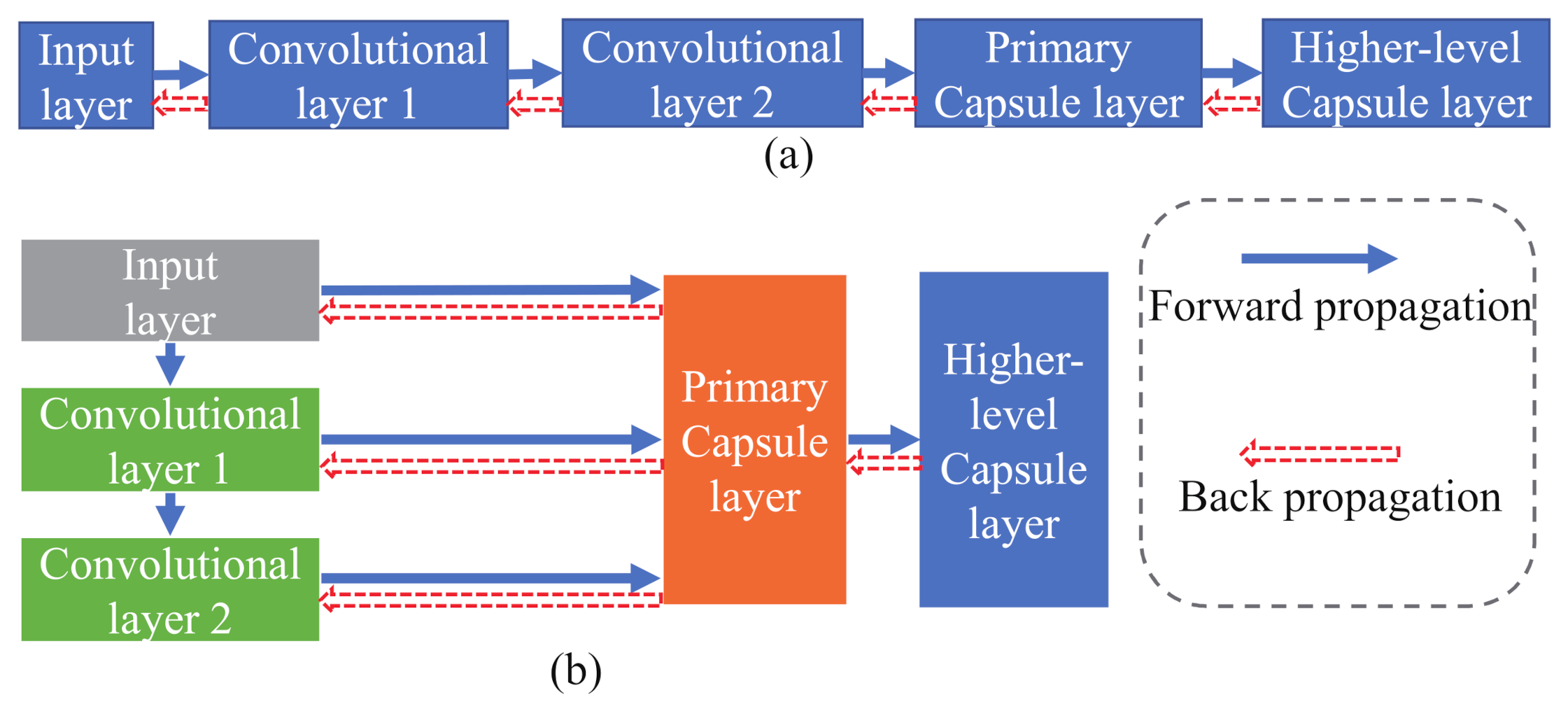
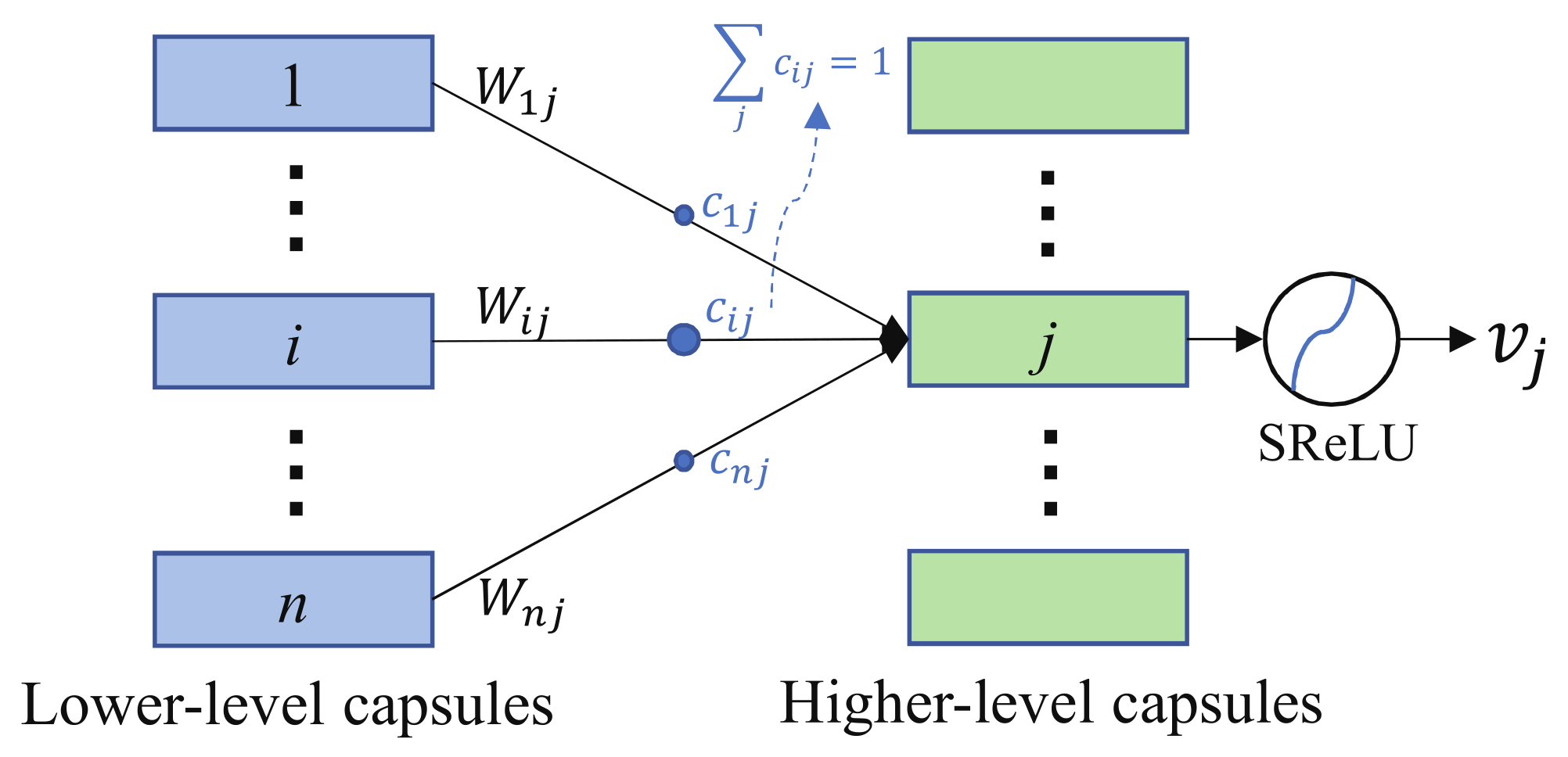
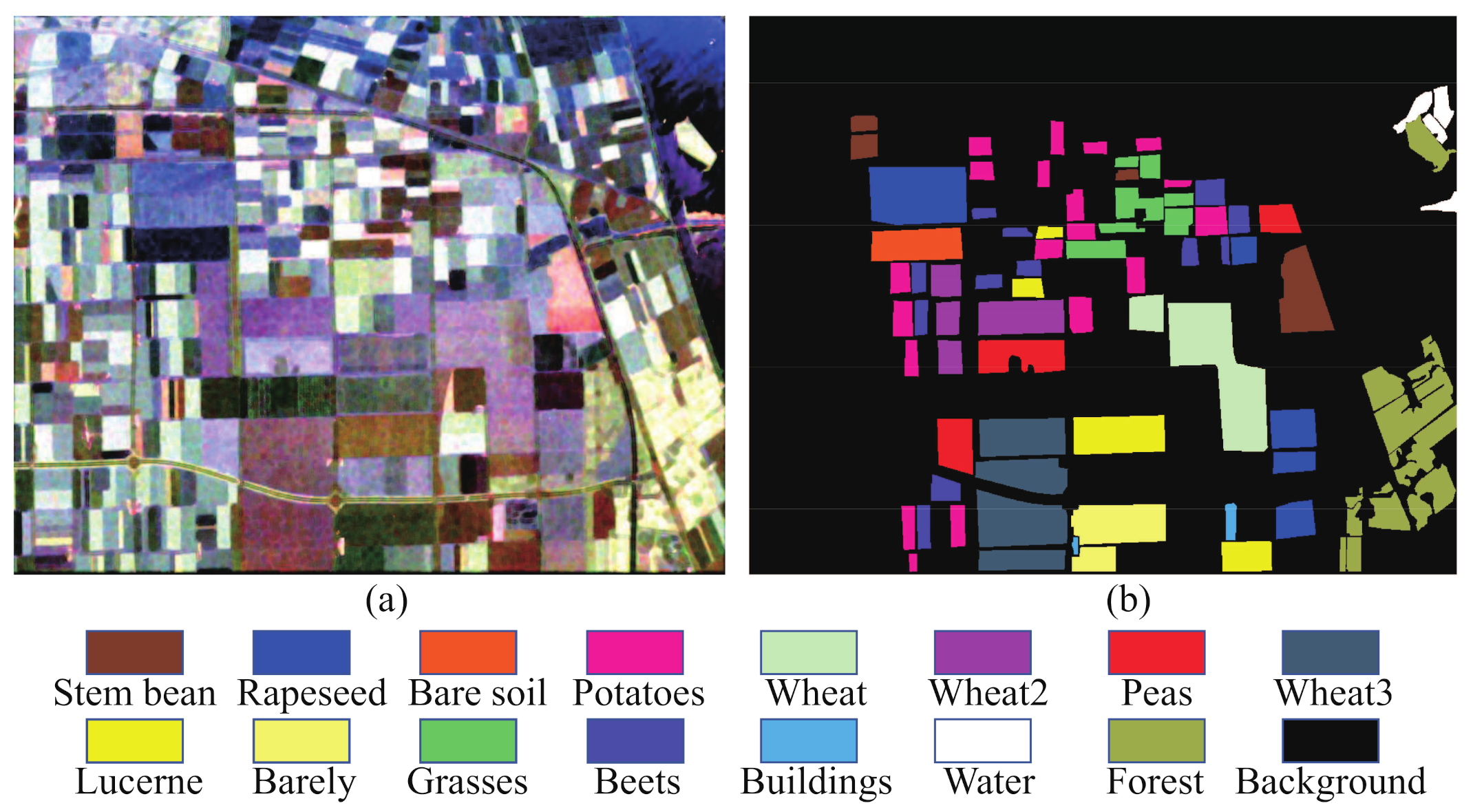


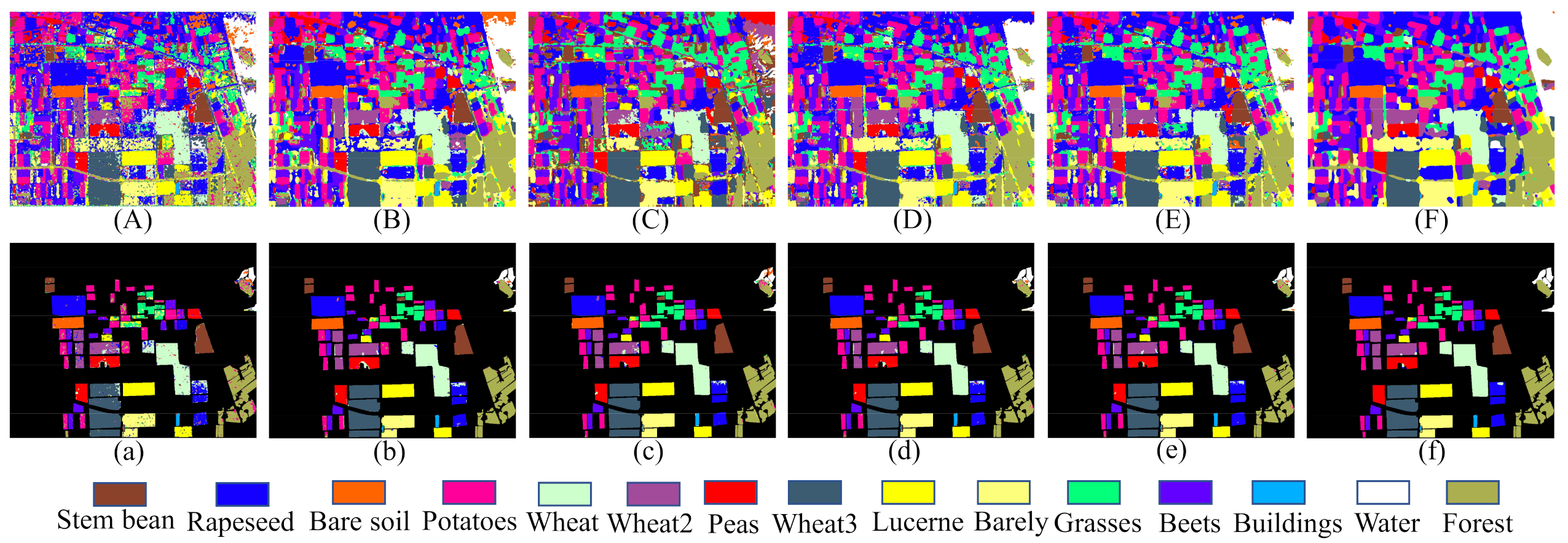
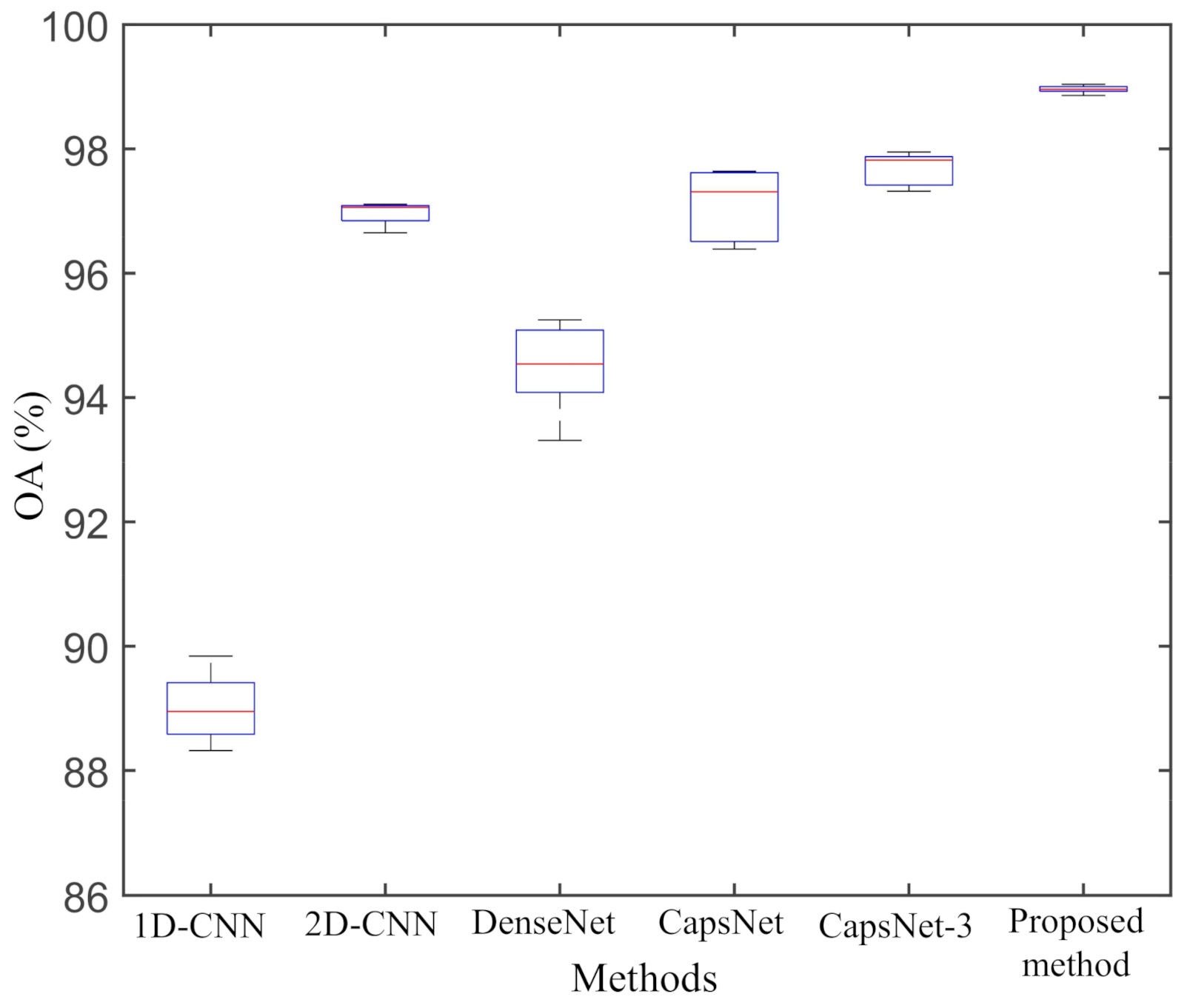



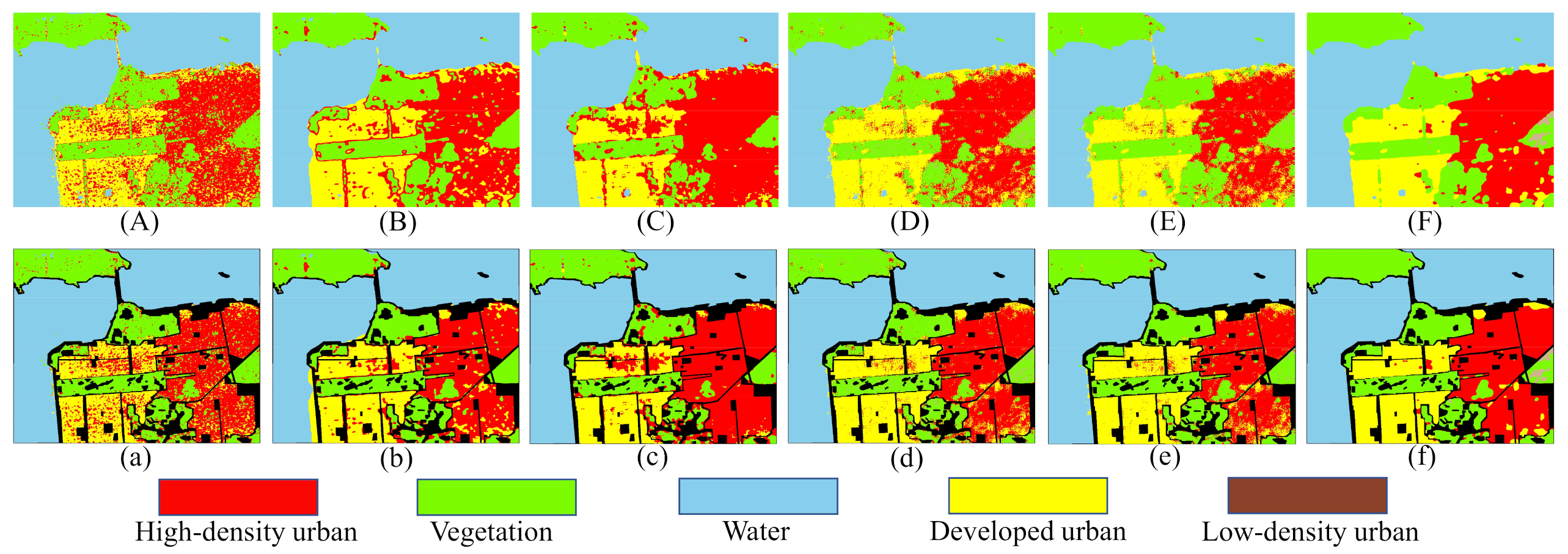
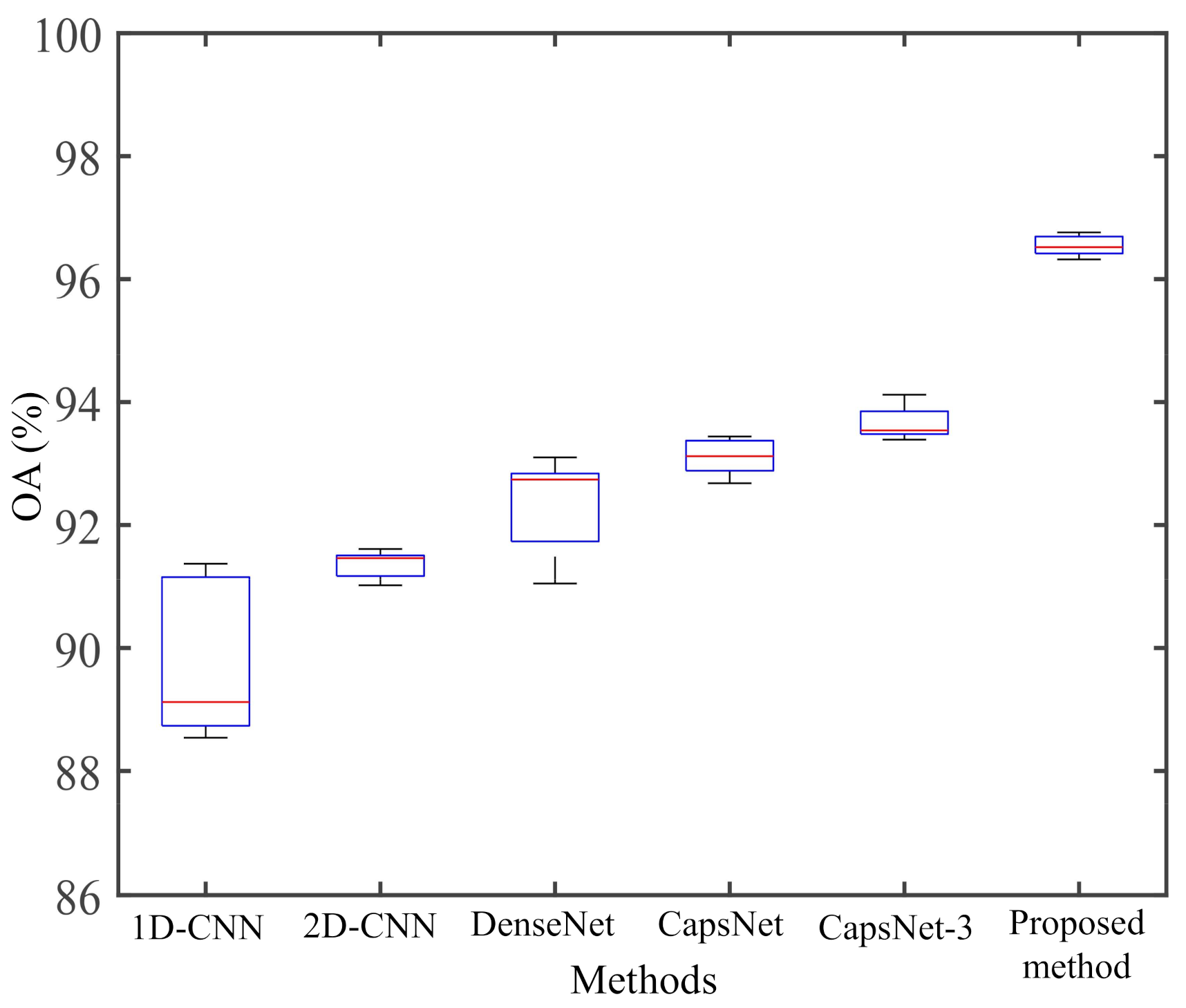


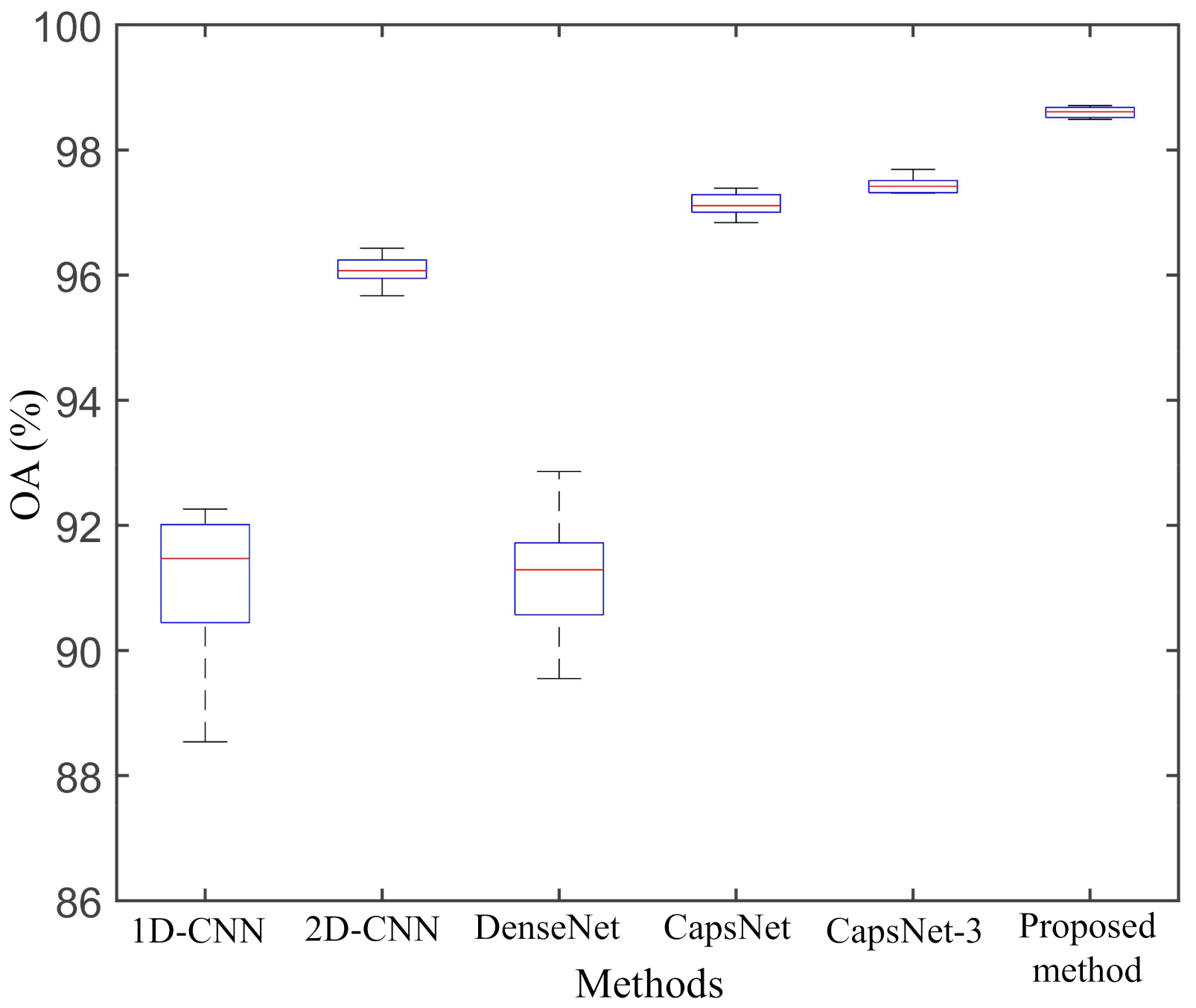
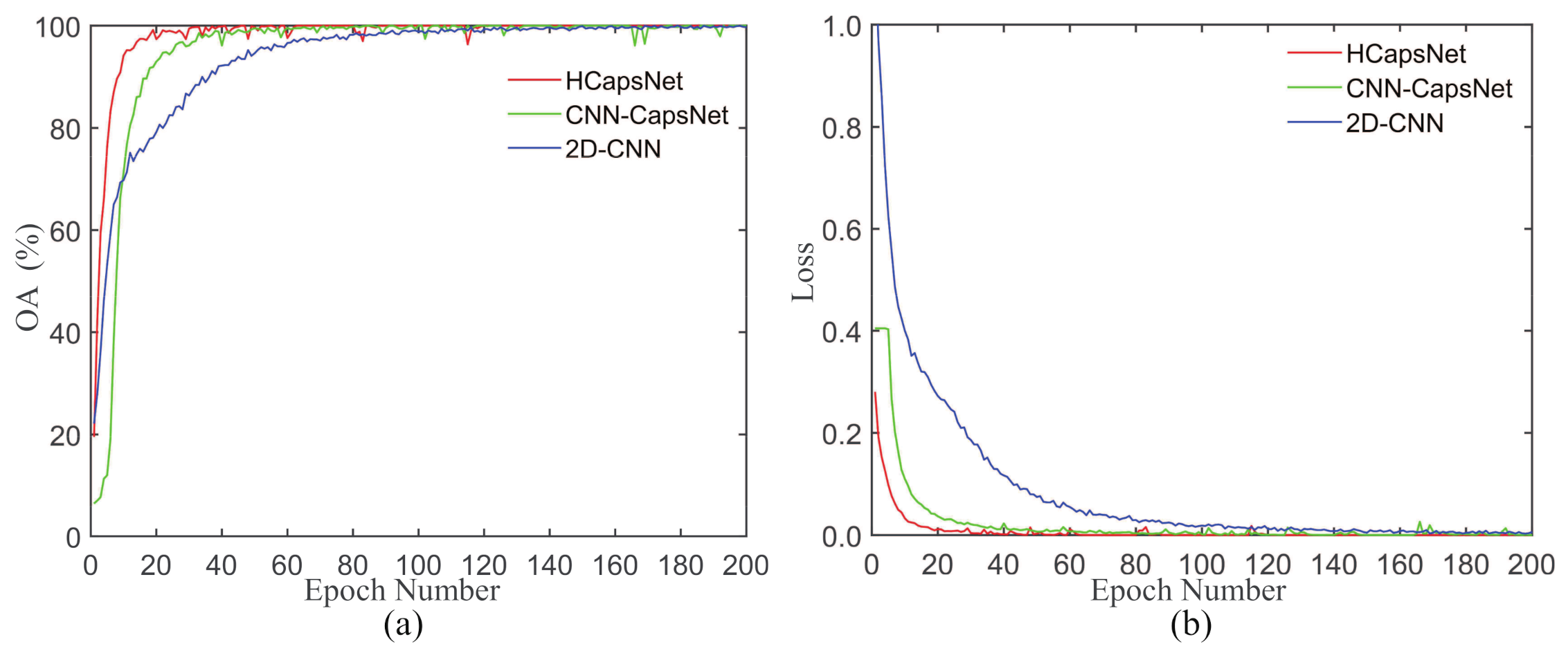







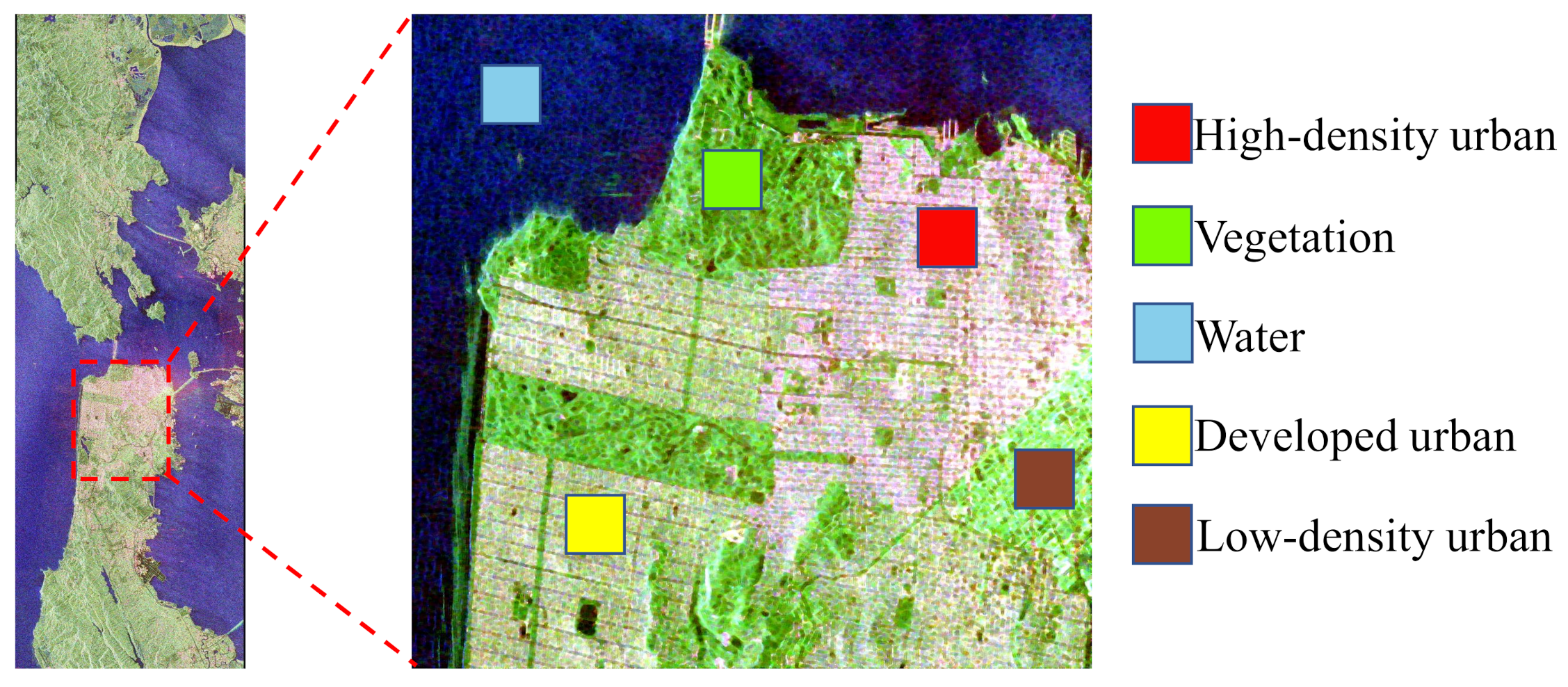
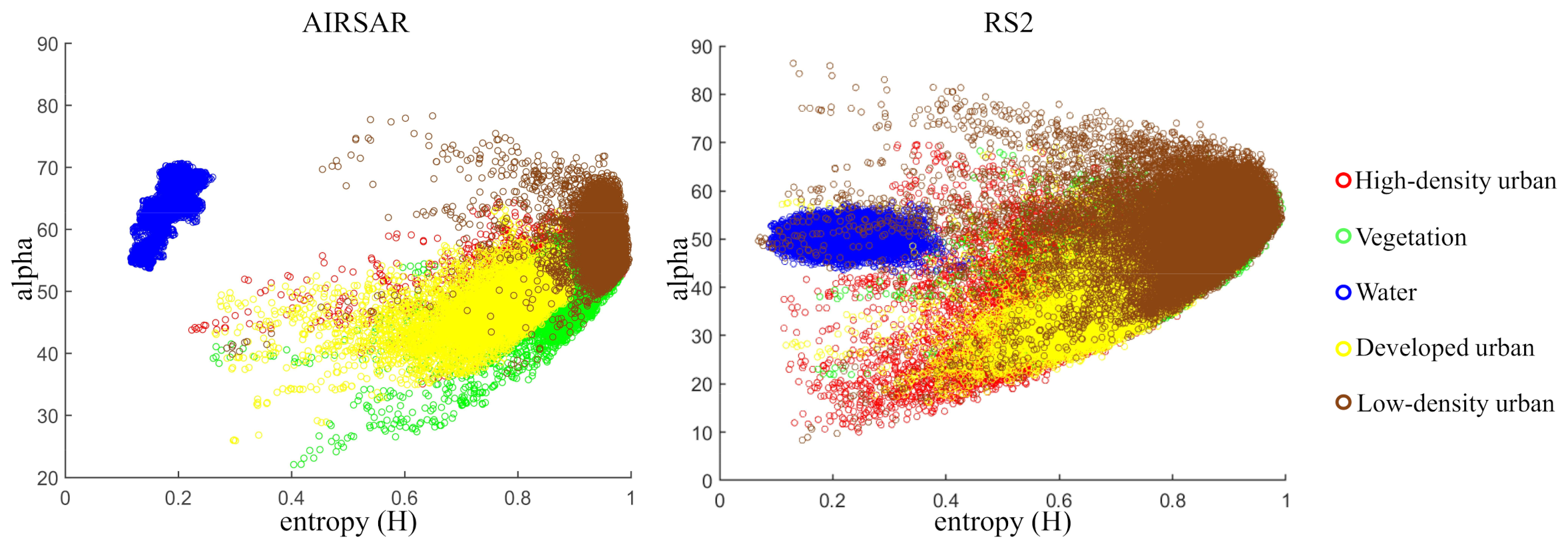


| H | A | ||||||
| phase | amplitude | polarimetric decomposition | |||||
| Platform | Windows 10 |
| Keras/TensorFlow | V 2.2.4/V 1.13.1 |
| CPU | Intel Core i7-10700K |
| Memory | 16 G |
| GPU | Nvidia GeForce RTX 2080 SUPER |
| Video memory | 8 G |
| Class | Name | Train | Test | Total |
|---|---|---|---|---|
| 1 | Stem bean | 1.00% | 99.00% | 8764 |
| 2 | Rapeseed | 1.00% | 99.00% | 19,326 |
| 3 | Bare soil | 1.01% | 98.99% | 5340 |
| 4 | Potatoes | 1.00% | 99.00% | 17,758 |
| 5 | Wheat | 1.00% | 99.00% | 17,636 |
| 6 | Wheat2 | 1.00% | 99.00% | 10,371 |
| 7 | Peas | 1.01% | 98.99% | 10,417 |
| 8 | Wheat3 | 1.00% | 99.00% | 22,090 |
| 9 | Lucerne | 1.00% | 99.00% | 10,967 |
| 10 | Barely | 1.01% | 98.99% | 8601 |
| 11 | Grasses | 1.00% | 99.00% | 8365 |
| 12 | Beets | 1.00% | 99.00% | 10,161 |
| 13 | Buildings | 1.11% | 98.89% | 904 |
| 14 | Water | 1.01% | 98.99% | 3477 |
| 15 | Forest | 1.00% | 99.00% | 22,841 |
| Total | 1.00% | 99.00% | 177,018 |
| Class | Name | Train | Test | Total |
|---|---|---|---|---|
| 1 | High-density urban | 0.50% | 99.50% | 163,370 |
| 2 | Vegetation | 0.50% | 99.50% | 157,698 |
| 3 | Water | 0.50% | 99.50% | 332,252 |
| 4 | Developed urban | 0.50% | 99.50% | 110,918 |
| 5 | Low-density urban | 0.51% | 99.49% | 12,263 |
| Total | 0.50% | 99.50% | 776,501 |
| Class | Name | Train | Test | Total |
|---|---|---|---|---|
| 1 | Bare soil | 0.21% | 99.80% | 23,038 |
| 2 | Forest | 0.20% | 99.79% | 39,099 |
| 3 | Cole | 0.20% | 99.80% | 49,588 |
| 4 | Wheat | 0.20% | 99.80% | 35,121 |
| 5 | Grasses | 0.21% | 99.79% | 10,214 |
| 6 | Water | 0.20% | 99.80% | 5382 |
| 7 | Sand | 0.21% | 99.79% | 10,213 |
| 8 | Wetland | 0.56% | 99.44% | 893 |
| Total | 0.20% | 99.80% | 173,550 |
| Class | 1D-CNN | 2D-CNN | DenseNet | CapsNet | CapsNet-3 | Proposed Method |
|---|---|---|---|---|---|---|
| Steam bean | 94.57 | 99.23 | 99.48 | 99.10 | 99.15 | 99.29 |
| Rapeseed | 89.77 | 95.32 | 95.31 | 96.16 | 98.15 | 98.84 |
| Bare soil | 98.01 | 99.56 | 98.15 | 99.85 | 99.92 | 100.00 |
| Potatoes | 86.52 | 96.55 | 95.37 | 99.45 | 99.24 | 99.72 |
| Wheat | 90.84 | 96.86 | 95.83 | 98.57 | 97.16 | 99.84 |
| Wheat2 | 83.68 | 96.27 | 83.14 | 96.39 | 96.26 | 98.28 |
| Peas | 92.35 | 93.64 | 92.72 | 96.52 | 97.03 | 98.30 |
| Wheat3 | 96.24 | 99.85 | 99.90 | 99.75 | 99.96 | 99.98 |
| Lucerne | 92.60 | 96.16 | 96.41 | 95.43 | 95.31 | 97.08 |
| Barley | 91.91 | 98.39 | 98.04 | 99.74 | 99.90 | 99.87 |
| Grasses | 69.11 | 97.30 | 96.51 | 99.29 | 99.08 | 99.12 |
| Beets | 89.92 | 93.84 | 95.90 | 96.19 | 96.05 | 97.19 |
| Buildings | 68.36 | 92.17 | 6.97 | 74.50 | 88.37 | 91.92 |
| Water | 64.91 | 88.99 | 56.57 | 88.03 | 88.52 | 99.57 |
| Forest | 89.15 | 98.43 | 96.32 | 94.91 | 96.88 | 99.15 |
| OA | 89.27 | 96.91 | 94.58 | 97.31 | 97.74 | 99.04 |
| AA | 86.53 | 96.17 | 87.11 | 95.59 | 96.73 | 98.54 |
| Kappa | 0.8824 | 0.9665 | 0.9406 | 0.9754 | 0.9783 | 0.9895 |
| Class | 1D-CNN | 2D-CNN | DenseNet | CapsNet | CapsNet-3 | Proposed Method |
|---|---|---|---|---|---|---|
| High-density urban | 82.48 | 86.62 | 97.37 | 86.51 | 83.50 | 92.62 |
| Vegetation | 91.49 | 92.83 | 85.14 | 90.56 | 96.64 | 97.32 |
| Water | 99.56 | 97.70 | 99.94 | 99.80 | 99.64 | 99.96 |
| Developed urban | 74.10 | 88.13 | 85.47 | 94.83 | 95.23 | 97.84 |
| Low-density urban | 0.00 | 0.00 | 0.00 | 17.38 | 7.22 | 33.28 |
| OA | 89.12 | 91.47 | 92.75 | 93.12 | 93.54 | 96.52 |
| AA | 69.52 | 73.06 | 73.58 | 77.82 | 76.44 | 84.20 |
| Kappa | 0.8460 | 0.8799 | 0.8974 | 0.9032 | 0.9091 | 0.9510 |
| Class | 1D-CNN | 2D-CNN | DenseNet | CapsNet | CapsNet-3 | Proposed Method |
|---|---|---|---|---|---|---|
| Bare soil | 94.39 | 97.43 | 99.62 | 96.78 | 97.5 | 99.09 |
| Forest | 98.85 | 99.96 | 99.86 | 99.99 | 99.98 | 100 |
| Cole | 99.59 | 99.49 | 99.84 | 98.63 | 99.33 | 99.91 |
| Wheat | 99.47 | 98.99 | 92.34 | 99.1 | 99.28 | 99.99 |
| Grasses | 24.39 | 65.58 | 23.96 | 85.17 | 80.78 | 88.77 |
| Water | 64.68 | 66.09 | 76.66 | 78.04 | 80.96 | 85.97 |
| Sand | 69.58 | 98.23 | 75.31 | 93.81 | 95.56 | 99.58 |
| Wetland | 47.48 | 85.44 | 39.87 | 93.06 | 96.53 | 95.74 |
| OA | 91.16 | 96.04 | 91.36 | 97.04 | 97.32 | 98.71 |
| AA | 74.8 | 88.9 | 75.93 | 93.07 | 93.74 | 96.13 |
| Kappa | 0.8886 | 0.9504 | 0.8914 | 0.963 | 0.9665 | 0.9838 |
| 2D-CNN | CNN-CapsNet | HCapsNet (without CRF) | |
|---|---|---|---|
| Layer 1 | Input. 8 @ 15×15 | Input. 8 @ 15×15 | Input. 8 @ 15×15/“Reshape” |
| Layer 2 | Conv. 128 @ 3×3 | Conv. 128 @ 3×3 | Conv. 128 @ 3×3/“Reshape” |
| Layer 3 | Conv. 256 @ 3×3 | Conv. 256 @ 3×3 | Conv. 256 @ 3×3/“Reshape” |
| Layer 4 | Max_pooling/Flatten | “Reshape” | Concatenate |
| Layer 5 | Fully Connected | Primary Capsule | Primary Capsule |
| Layer 6 | Dropout | Higher-level Capsule | Higher-level Capsule |
| Layer 7 | Softmax | Length | Length |
| Method | Sample Rate | OA | AA | Kappa |
|---|---|---|---|---|
| MCCNN [52] | 1% | 95.83% | 96.02% | / |
| Compact and Adaptive CNNs [57] | 1% | 96.35% | / | / |
| CK-HDRF [58] | 1% | 96.75% | 97.00% | 0.9569 |
| RCV-CNN [13] | 1% | 97.22% | 95.99% | 0.8930 |
| HCapsNet without CRF | 1% | 98.34% | 97.44% | 0.9818 |
| HCapsNet with CRF | 1% | 99.04% | 98.54% | 0.9895 |
| Data Set | Accuracy | Dense- CapsNet | Res- CapsNet | CNN- CapsNet | HCapsNet (without CRF) | HCapsNet (with CRF) |
|---|---|---|---|---|---|---|
| AIRSAR | OA | 97.40 | 97.67 | 97.88 | 98.34 | 99.04 |
| Flevoland | AA | 95.45 | 96.52 | 96.21 | 97.44 | 98.54 |
| dataset | Kappa | 0.9715 | 0.9745 | 0.9769 | 0.9818 | 0.9895 |
| AIRSAR | OA | 91.44 | 93.89 | 93.88 | 94.34 | 96.52 |
| San Francisco | AA | 73.08 | 75.75 | 76.11 | 82.52 | 84.20 |
| dataset | Kappa | 0.8796 | 0.9136 | 0.9135 | 0.9204 | 0.9510 |
| GF-3 | OA | 93.45 | 96.58 | 97.12 | 97.86 | 98.71 |
| Hulunbuir | AA | 80.57 | 94.50 | 90.87 | 94.51 | 96.13 |
| dataset | Kappa | 0.9176 | 0.9575 | 0.9641 | 0.9731 | 0.9838 |
Publisher’s Note: MDPI stays neutral with regard to jurisdictional claims in published maps and institutional affiliations. |
© 2021 by the authors. Licensee MDPI, Basel, Switzerland. This article is an open access article distributed under the terms and conditions of the Creative Commons Attribution (CC BY) license (https://creativecommons.org/licenses/by/4.0/).
Share and Cite
Cheng, J.; Zhang, F.; Xiang, D.; Yin, Q.; Zhou, Y.; Wang, W. PolSAR Image Land Cover Classification Based on Hierarchical Capsule Network. Remote Sens. 2021, 13, 3132. https://doi.org/10.3390/rs13163132
Cheng J, Zhang F, Xiang D, Yin Q, Zhou Y, Wang W. PolSAR Image Land Cover Classification Based on Hierarchical Capsule Network. Remote Sensing. 2021; 13(16):3132. https://doi.org/10.3390/rs13163132
Chicago/Turabian StyleCheng, Jianda, Fan Zhang, Deliang Xiang, Qiang Yin, Yongsheng Zhou, and Wei Wang. 2021. "PolSAR Image Land Cover Classification Based on Hierarchical Capsule Network" Remote Sensing 13, no. 16: 3132. https://doi.org/10.3390/rs13163132
APA StyleCheng, J., Zhang, F., Xiang, D., Yin, Q., Zhou, Y., & Wang, W. (2021). PolSAR Image Land Cover Classification Based on Hierarchical Capsule Network. Remote Sensing, 13(16), 3132. https://doi.org/10.3390/rs13163132







